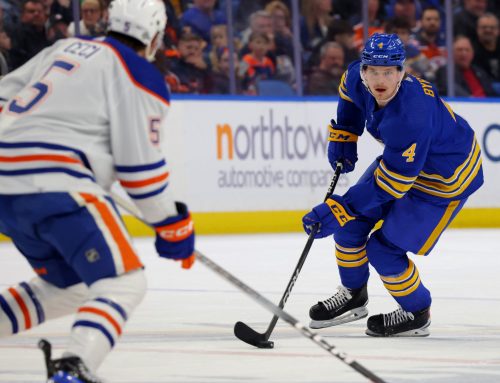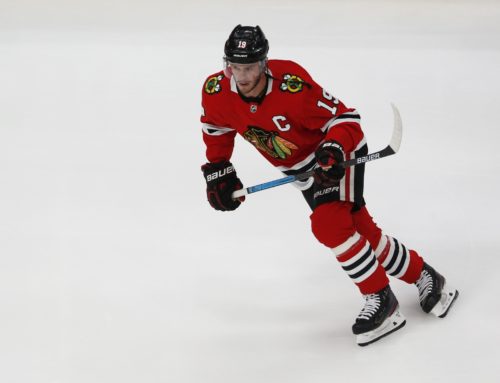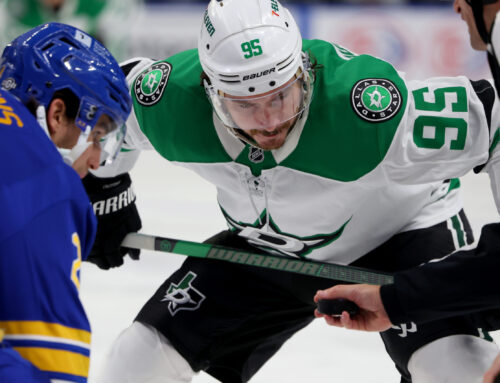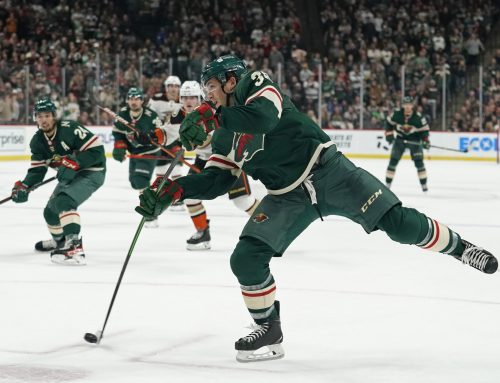Last week, these Ramblings started digging into my personal point projections. We started with groups of forwards all in the same tier of production, moved on to some players with surprising (to me) projections, and finished with attackers that had notable increases/decreases in projected production when compared to 2022-23. For thoughts on a few dozen forwards and their points outlook, go read those articles. And grab a copy of the 2023-24 Dobber Fantasy Hockey Guide while you're on the site!
For this week, we are going to focus on defencemen. The position has been constantly evolving for about a decade now and it makes them a lot of fun to break down. As with the forward articles, there are four caveats: This is my first run of projections so things will change (and perhaps by a lot) for some rearguards over the next month; there is no position splitting so everyone is listed as 'D' rather than LD/RD; first-year players are not included and will be added at a later date; all starters are projected for 82 games played. Cool? Cool.
Data from our Frozen Tools, Natural Stat Trick, or AllThreeZones, unless otherwise indicated. I am not going to talk about Quinn Hughes today because his projection spit out something really weird (read: far too low) and it's an issue that needs some investigating. He may end up in the first group we're looking at, which is…
The 80-Plus Group

Let's start at the tippy-top with the defencemen carrying the four highest projections. Three of these four players have all had at least one season of 80-plus points, with Adam Fox being the exception and he's averaged 75 points/82 games over the last two years. If we projected Roman Josi to play 72 games and Erik Karlsson to play 68, things would change a lot, but as we mentioned earlier, everyone is projected to play 82. Let's briefly go over each of them.
We only need to look at what Cale Makar has done recently – averaging 91 points/82 games over the last two seasons – to understand why he's at the top of the list. He doesn't even need a full season to lead defencemen in points, but imagine if Colorado is firing on all cylinders and he plays 80 games? It is a wonder if they don't throttle his minutes back a bit, but he should be the first defenceman off the board in any non-cap format.
Erik Karlsson putting up 87 points would be a big step back from a year ago, but it would still be an elite total across the league. There is more discussion including Karlsson a bit further down this list.
What is projected for Roman Josi is partly a product of his 2021-22 season when he posted 96 points. Last season, he had 0.88 points/game, and that number was 0.69 points/game in the Bubble season. It looks like Nashville is starting to turn the keys over to the next generation and that makes his upside very tenuous. He will have to do a lot of heavy lifting to get over 80 points and I think this projection is too high.
Adam Fox is the interesting player in this group. He has never hit 80 points, but he clearly has the talent, the role, and the supporting cast to get there. When I looked into his projection a bit more, it seems a big reason for this is that the assumption is all of Filip Chytil, Kaapo Kakko, and Alexis Lafrenière take steps forward in even-strength production, and that will filter down to Fox. If that doesn't happen, then 70-75 points seems likely once again, so the Kid Line has a lot riding on it this season in more ways than one.
The Tampa Boys

The discrepancy between the two here basically comes down to age. Mikhail Sergachev is in the meat of his prime, having turned 25 years old over the summer, while Victor Hedman will turn 33 years old in December. Sergachev is projected for more even-strength points and a few more PP points as the assumption is a 60/40 split in top PPTOI in his favour.
Assumptions can be a pitfall so if the PPTOI split is heavily in Hedman's favour, or his age-related decline isn't an issue, we could easily see the numbers reverse themselves. I do believe, though, that the team is ready to hand the reigns to Sergachev to try and ease Hedman's workload a bit as they focus on another Stanley Cup. In multi-cat formats, Sergachev has a profile that gives him top-fantasy-defenceman upside.
Competitive Spirit

Here we have a group of players that have internal competition from Jakob Chychrun, Karlsson, and Brent Burns. They are all still carrying strong projections, though, so we need to look a bit more into it.
Ottawa's blue line has a lot of good options and it'll be interesting to see how they work the power play units. My projections have Chabot as the lone defenceman on the top PP unit for nearly three-quarters of the season and with the team's penchant for drawing power plays, that means a lot of PPTOI. More progression from the young forwards is keeping Chabot's projection very high. A large, positive even-strength regression for basically the entire team is in the cards, and that's why we have the projection shown.
One secret to fantasy hockey this year is that Letang is one of the bigger positive regression candidates on any blue line. The team shot 8.14% with him on the ice at even strength in 2022-23, a seven-year-low. He also registered a point on just 31.7% of even-strength goals scored with him on the ice, his lowest mark since his rookie 2007-08 season (had been over 42% in each of the previous four seasons). Playing the 'what if' game is dangerous, but if Pittsburgh shoots 10.5% at even strength with Letang on the ice (his three-year average) rather than 8.1%, and he registers a point on 45% of those goals (rather than 31.7%), he quite literally would have had 16 more points last season, finishing with 57 in 64 games rather than 41. That works out to a 73-point season so even when factoring in some PPTOI lost to Karlsson's arrival, a 61-point projection for 82 games doesn't seem unreasonable.
Seeing what Tony DeAngelo did in Carolina in his first go-round makes this projection sensible when he's slated as the top PP quarterback. The problem for his point production will come in two forms: Brent Burns taking some top PPTOI, and a lot of competition for even-strength time with Burns, Dmitry Orlov, Jaccob Slavin, and Brett Pesce all ahead of him for sure, and maybe Brady Skjei, too. It wouldn't be surprising to see him with a 68-point season or a 38-point season all depending on how he is used and how many games he actually plays. Buyer beware.
Second Fiddles

These differ from the competition section because all three here are clearly behind a high-end option at the top of the lineup. I suppose we can have the Hampus Lindholm/Charlie McAvoy debate, but I'd rather not right now.
It will be very interesting to see what Colorado does with Devon Toews this season. He is an unrestricted free agent at the end of the campaign and with $76M in cap commitments for 2024-25, it's probably his last in Colorado. Do they just let him walk at the end of the season or trade him at the Deadline? My guess is the former, but we'll find out in six months.
Shayne Gostisbehere was (presumably) brought in to run the top PP unit and that's what is floating much of his projection here. Moritz Seider could eat into some of that PPTOI, Jake Walman has solidified himself as a top-4 blue liner, and they brought in Jeff Petry and Justin Holl. Even if Gostisbehere runs the top PP unit for most of the year, he is still uncertain to play 20 minutes a night.
McAvoy has a higher projection than Lindholm, but the power-play output is still uncertain. The projections assume they basically split the top PP duties and that means expecting much more than 20 PPPs from either guy is lofty, especially when factoring in the losses of Patrice Bergeron and David Krejci.
Young Stars

Lastly, we'll finish with a quartet of young blue liners with one of them being projected much lower than the other three.
It would be something for Colorado to have three 45-point defencemen, especially running a 4F/1D top PP unit, but that's what is expected here if all of Makar, Toews, and Bowen Byram play 82 games. Last season, Byram had more scoring chances per minute at 5-on-5 than names like Josi and Evan Bouchard, and assisted on teammate scoring chances more than Thomas Chabot and Vince Dunn. He is a tremendous player and is only getting better.
It really does not seem far-fetched for Owen Power to add 10 points to his total from last year in his second full season (third overall). Even if he is not a high-end playmaker yet, the Sabres should be phenomenal offensively at even strength and that, on top of progression from Power himself, is the reason for the big production jump.
Calen Addison's projection is powered by slotting as Minnesota's top PP quarterback. If, for whatever reason, Jared Spurgeon or even Brock Faber eats significantly into Addison's top PPTOI, it could be a very rough fantasy season for the young defenceman. He was given little ice time at even strength last year and if he's not earning top PP time, there really isn't much else to get excited about here, fantasy-wise. He is about as boom/bust as it gets for any player in the league.
Lastly, we have Cam York. He is a guy I had pegged for a breakout this season, but the worry is Philadelphia's power play. It wasn't very good last year but the hope is having both Sean Couturier and Cam Atkinson healthy will give them a much-needed boost. Even with DeAngelo now in Carolina, Rasmus Ristolainen got more PPTOI than York down the stretch last season. The assumption in the projections is York getting half the top PPTOI for the season but on a very bad power play. If he can get, say, 80% of the top PPTOI and the Flyers have anything approaching an average power play, York is a 40-point threat. Even with a poor number here, I am buying into him as a late-round pick and think his projection will creep up as more updates are made.
One Comment
Leave A Comment
You must be logged in to post a comment.





 CHI
CHI SEA
SEA FLA
FLA DAL
DAL WPG
WPG CBJ
CBJ L.A
L.A MIN
MIN DET
DET

Where is Rasmus Dahlin??